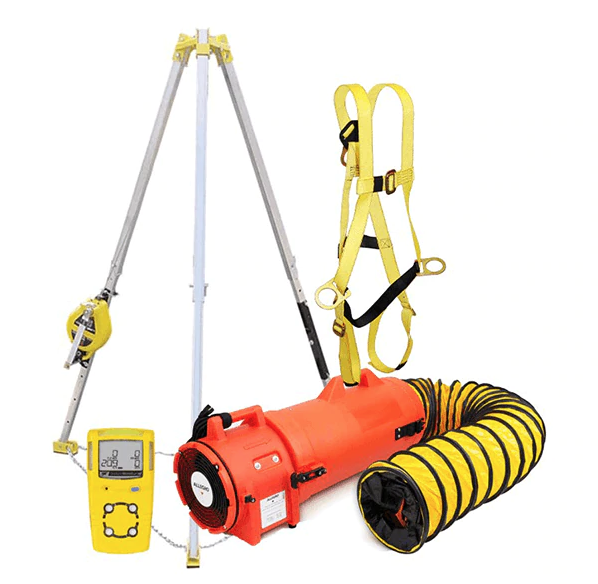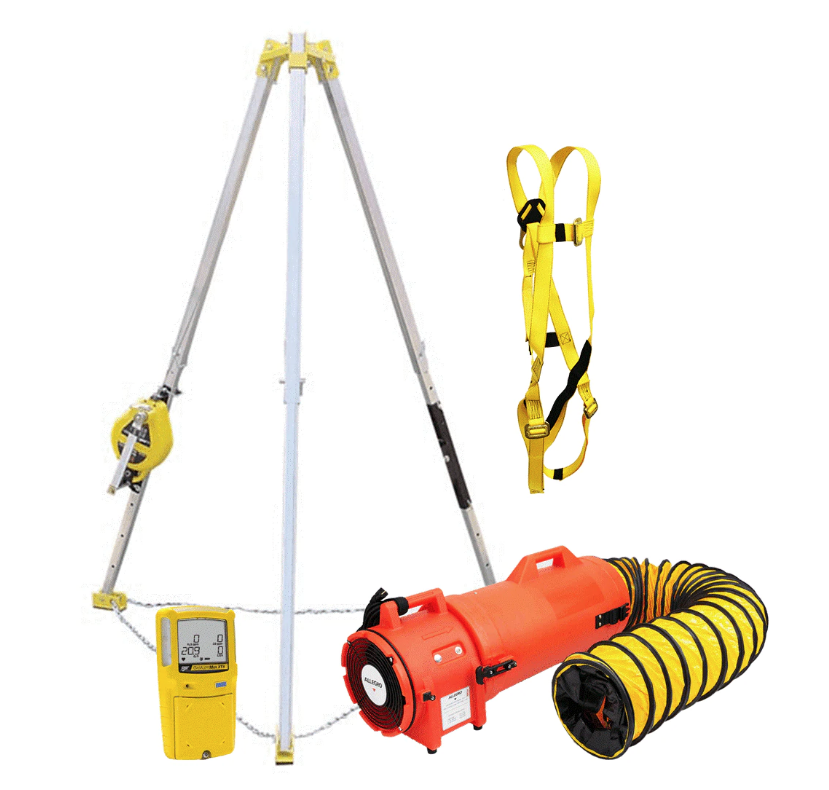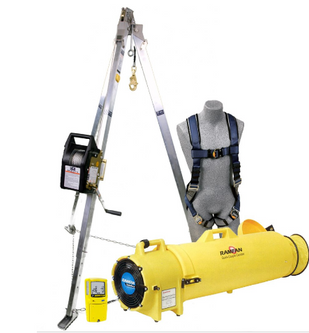What is Industrial Confined Space Rescue?
Anyone regularly working in confined spaces knows they can be dangerous; yet confined space work is crucial to a wide variety of industries. When work is being performed in confined spaces, rescue plans must be in place in the event of an accident. Petrochemical sites such as oil rigs, refineries and drug manufacturers need regular site inspection and maintenance; wastewater treatment plants, or other businesses requiring workers to go down into the sewers or tanks also require frequent confined space entry.
Rescue in industrial confined spaces must be a well thought-out event where rescue personnel are familiar with the dangers of the entire work site and the particular space in question because of testing, research and documentation. Too much can go wrong for companies to rely upon sporadic safety drills and forgotten or non-existent rescue plans.
What are the dangers?
Aside from the fact that these cramped, dark spaces are inherently uncomfortable and constricting, confined spaces often are stagnant areas where toxic and flammable gases and liquids can accumulate. It is the lack of oxygen, the possibility of explosion from accumulated gas, and the overexposure of dangerous gases on workers respiratory systems that form the greatest risks.
If safety procedures aren’t followed or there is an accident, it only takes four minutes without sufficient oxygen for brain damage (or death) to occur. It is crucial for companies to follow the Occupational Health and Safety Administration (OSHA) guidelines and develop their own site-specific response plans as well as fostering a culture of safety and accountability in their companies.
What does the OSHA say?
OSHA Standards require any confined space access to have verifiable knowledge of the space before workers enter. This involves site assessment, appropriate training, emergency planning and having the right equipment for the job. OSHA Standards were set up to provide safety for the many industrial jobs in confined spaces that are inherently unsafe. By requiring ventilation, gas detection, safety procedures, and rescue plans, OSHA has worked out sets of rules companies must follow before sending workers into these spaces.
Technical rescue personnel are trained in these types of confined spaces for years before they are deemed competent to evaluate and enter confined spaces in a rescue situation. Even assistants who will not be entering the contaminated area must have continued training in confined space procedures at least once a year. More frequent training is recommended in many states, and mandatory in others. Confined space rescue plans and procedures must also be developed and in place from the company who controls the site; if problems do occur while workers are in dangerous areas, there is a plan to get them back out in a timely manner. This is especially important since confined spaces are, by definition, difficult to enter and exit, and retrieval of workers can be both awkward and time-consuming.
As well as training and rescue plans, confined space access on industrial sites often requires specialized equipment such as gas detectors which check the air of a confined space for harmful gas levels before workers enter. Generally a handheld 4-gas detector is used for confined spaces, and workers keep these on them at all times. The newer generation of these detectors offer wireless alerts, allowing safety teams to track alarms from a remote office and enact rescue procedures more quickly.
Rescue Me!

Anyone involved in confined space rescue has heard the OSHA statistics that indicate two-thirds of confined space fatalities occur among the parties attempting to rescue the initial downed worker. Injuries occur when coworkers are overcome by emotion and take unnecessary chances. Often this is a result of lack of training and absence of a worksite rescue plan.
There are essentially three types of confined space rescue procedures, and the first is the most idyllic: Simply put, workers rescue themselves.
Self-rescue is the preferred method in confined spaces because the hazards are so quick to incapacitate and kill. To rescue themselves workers need training to recognize and be aware when a situation becomes dangerous. Gas monitors can be crucial in alerting a confined space team to hazards that are either present as they enter the space, or that may develop during their work (or because of it - in the case of welding, or other gas producing work in areas with limited ventilation). With proper warning and awareness of dangers, workers are able to evacuate the confined space when they are alerted to danger.
The second rescue method is ‘non-entry rescue’ and occurs when someone is incapacitated in the space and can be extracted using a winch attachment or similar equipment without the rescuers entering the dangerous space. If a worker is wearing a full-body harness and is attached to a winch with a steel cable, outside workers are often able to crank the winch and pull the injured worker to safety without endangering themselves. Wristlets are sometimes used if the access point (manway, hatch, etc.) is too narrow for the use of a harness. Some smaller tanks or vessels come to mind. This type of rescue removes the injured worker without endangering other workers by forcing them to enter a dangerous environment.
Non-entry rescue, of course, requires the right equipment be in place before the accident occurs. This can be an effective and less-risky solution to potentially life-threatening situations. Proper training and preparation are essential for this approach to be successful.
Finally there is full-blown confined space entry and rescue. This is riskiest for the rescuer and requires good planning and extensive training to be effective. The trained rescuer (or confined space entrant) must evaluate the confined space to determine what dangers await their potential rescue team. This is a crucial first step if the rescue team wants to avoid becoming another group of victims.
If the atmosphere of the confined space is toxic or oxygen depleted, worker rescue must happen in a very timely manner - an entry team only has four minutes once a worker passes out before worker rescue becomes body retrieval. Unless a worker is simply injured within a confined space, and not in a dire life-threatening predicament, the elapsed time it takes to get the rescue team onsite and set up is often too slow to save lives. This is why self-rescue and non-entry planning and preparation is so crucial in industrial confined space situations.
Once an entry team arrives on-site, they must deploy their equipment - a tripod or other overhead anchor points and winch or similar rope access system, they must test the air with a gas detector, secure the immediate area and put on their harnesses, helmets and other personal protective gear - before the rescue attempt can be made. All this takes precious time as the incapacitated workers continue to be subjected to the dangerous atmosphere that may have caused the problem in the first place.
It should be noted that OSHA does not recognize the local fire department rescue squad as a planned strategy unless they (the fire department) have been brought on-site prior to the confined space entry, and are committed to being on hand for the duration of rescue operations in a stand-by capacity.
The entry rescue team will, at a minimum, be comprised of an attendant who can perform non-entry rescue or call for additional help, a rescue entry supervisor who is aware of all known confined space hazards and can verify that safe entry conditions have been attained, and the confined space entrant. The authorized entrant is highly trained in confined space entry, knows the hazards and has all necessary personal protective equipment (PPE) needed. They will be the one to enter the confined space, carry out the rescue plan and communicate with the outside team for worker removal.
Confined Space Entry & Rescue Equipment:
Air: Often times, a worker becomes incapacitated because oxygen levels have been depleted, or other hazardous gases, such as Hydrogen Sulfide (H2S) have increased in concentration to a level where the lungs fail or a worker passes out. A portable ventilation fan and ducting (such as the popular ECKO blower systems) can provide safety teams and rescuers with a simple method of targeted ventilation. These devices are common to manhole entry, and work to ventilate an area by pushing fresh air into a space (forced air ventilation), or can be used to extract fumes from an area. The choice depends upon the situation, and can only be assessed by a competent and trained rescue worker, but blowers are a simple and effective method of improving the air for a coordinated confined space rescue.
Another option is the pressure-demand air line respirator with emergency escape bottle that comprises the Self Contained Breathing Apparatus (SCBA) system. Rescue workers are sometimes forced to take their air with them, and although this is sometimes a cumbersome attachment in a small space, a reliable source of oxygen can allow a rescue worker to enter an otherwise uninhabitable area to secure the victim or clear obstacles to worker removal.
Tripod and Winch: Great for hatch or manhole access, a simple lightweight tripod and winch (such as the 7ft Aluminum Tripod & Winch Combination from DBI/SALA) is a common way of providing workers with a simple and rapid form of personnel retrieval. Geared winches provide the leverage to pull a heavy worker up and out of a space.
Harnesses and Extraction Tools: Along with a good tripod and rope access equipment, a good harness is essential. The ExoFit Rescue is specially designed with extra attachment points to secure an incapacitated team member. A Y-Lanyard is helpful in keeping the victim vertical during egress, and simplifying the extraction process. Gas Detection: There are a wide range of multi-gas monitors that detect the common gases: Hydrogen Sulfide, Oxygen, Carbon Monoxide and Lower Explosive Levels of a variety of combustibles. More sophisticated gas detectors can also be customized to detect the specific gases that may be produced in certain industrial plants and factories. The Gas Alert Max range or MultiRAE devices (for wireless data transmission) will help your team stay appraised of dangerous gas levels in order to help avoid accidents in the first place.
Confined space rescue in industrial environments is serious business, with potentially deadly consequences. However, as the saying goes: luck favors the prepared. With proper planning, training and the right gear, the job becomes predictably safer. Industrial confined space rescue involves preparing not only for what to do when there is an accident, but also how to prevent accidents from taking place. Rescue can be made safer by companies willing to take the steps so that self-rescue and non-entry rescue are viable options for all workers in the field.

Recent Posts
-
Customizing Gas Detectors: Tailoring Solutions to Fit Your Unique Requirements
In today’s diverse industrial landscape, a one-size-fits-all approach to safety simply doesn’t cu …Jul 3rd 2024 -
10 Ways to Prevent Wildfires
You can prevent wildfires by extinguishing flames before you leave the worksite. Avoid practicing …Jul 1st 2024 -
ANSI/ISEA 138 Safety Gloves: Ensuring Hand Protection
The human hand is an anatomical masterpiece and arguably the greatest tool attached to our bodies …Jun 25th 2024





